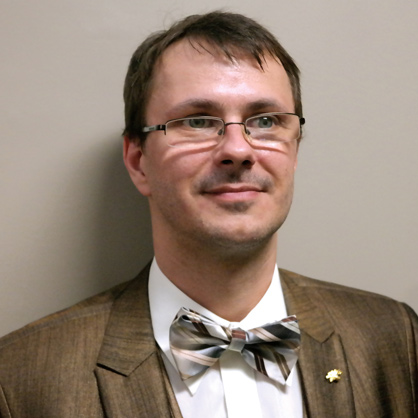In the Media
National Geographic: Do we live in a black hole?
Nikodem Poplawski, a distinguished lecturer of physics, comments on the theoretical possibility that the universe was formed in a black hole.

Nikodem Poplawski is interested in general relativity, analytical mechanics, and classical/quantum field theory. His research focuses on how gravity with spin and torsion can solve fundamental problems in cosmology. He proposed that torsion causes the formation of a new universe through a big bounce in every black hole and that our Universe is the interior of a black hole existing in another universe. This scenario was listed by National Geographic and Science magazines among their top ten discoveries of 2010. Dr. Poplawski also appeared in Curiosity on Discovery Channel, in an episode hosted by Morgan Freeman:Parallel Universes – Are They Real?
To find out more about Nikodem Poplawski, visit his website at http://comp.newhaven.edu/poplawski/
In the Media
Nikodem Poplawski, a distinguished lecturer of physics, comments on the theoretical possibility that the universe was formed in a black hole.
In the Media
Nikodem Poplawski, a distinguished lecturer of physics, was quoted from his interview with National Geographicon what black holes represent in the universe.
In the Media
Nikodem Poplawski, distinguished lecturer and coordinator of physics, comments on the idea that dark matter is composed of primordial black holes.
In the Media
Nikodem Poplawski, a distinguished lecturer of physics, discusses his hypothesis on how every black hole produces a new universe and, on the other side of the event, becomes an Einstein-Rosen Bridge, a wormhole.
In the Media
Nikodem Poplawski, professor and coordinator of physics, comments on black holes, the concept of the baby universe using the Einstein-Rosen Bridge, and how it resolves the Hawking paradox.
In the Media
Nikodem Poplawski, professor of physics, talks about how James Webb's telescope technology achieved dramatic pictures of space that are deeper than ever before.
In the Media
Nikodem Poplawski, professor of physics, talks about a theory that the universe was spit out from the bottom end of a black hole.
In the Media
Nikodem Poplawski, a distinguished lecturer of physics, talks about the big bang and how the universe originated and conducts a demonstration with research student Michael Del Grosso '22.
In the Media
Nikodem Poplawski, senior lecturer of physics, comments on the idea that dark matter is composed of primordial black holes.
In the Media
Nikodem Poplawski, senior lecturer and physics coordinator, explains how the results of a new study provides more evidence that a supermassive black hole lies within the Milky Way.
In the Media
Nikodem Poplawski, senior lecturer and physics coordinator, discusses black hole singularity and could be "one way door" to another universe.
Nikodem Poplawski, senior lecturer and coordinator of physics, comments on the birth of the universe and how black holes play into this theory.
Nikodem Poplawski, a brilliant senior lecturer and physics coordinator sometimes referred to as the next Einstein, describes his successful career in physics during an interview with Andrew Ostrowski.
Nikodem Poplawski, senior lecturer and physics coordinator, comments on the theory that while holes exist in the universe, and could be the origin of black holes.
Nikodem Poplawski, senior lecturer and physics coordinator, comments on the infinity of other "worlds" in our universe, where they are, and if we can locate them. In order to read the full article, you must subscribe to the publication.
Nikodem Poplawski, senior lecturer of physics, explains how our universe may exist inside a black hole.
Theoretical physicist, senior lecturer and physics coordinator Nikodem Poplawski discusses black holes on the 100th anniversary of Einstein's General Theory of Relativity.
Nikodem Poplawski, member of the University of New Haven's physics faculty was identified as a potential 'future Einstein' by Sparrho, a science-specific search engine accessing more than 1.3 million documents in the form of articles, patents, videos and even grants. Poplawski devised a theory that every black hole is a doorway to another universe, one of the top 10 discoveries of 2010.
Nikodem Poplawski, member of the University of New Haven’s physics faculty, suggests that the entire universe — all the galaxies, stars, planets, everything — exploded out of a black hole.
Nikodem Poplawski, member of the University of New Haven's physics faculty joins others in the latest issue of National Geographic in theorizing that the 'seed' of the pre-big bang universe - an incredibly small dense point of matter - was formed inside a black hole and that this tightly packed, protected 'seed' is exactly the sort of thing we might expect to be formed inside the black or grey holes we see in our own universe.
In the Media
Nikodem Poplawski, distinguished lecturer of physics, contributed an article that is showcasing some of the most interesting ideas in science by Inside Science, a news service of the American Institute of Physics.